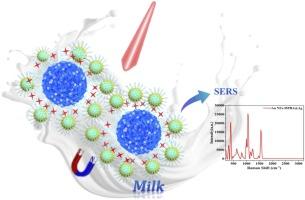Double enhanced flower-like SERS sensor based on aptamer modification for high specific recognition and sensitive rapidly detection of kanamycin
IF 3.7
1区 化学
Q1 CHEMISTRY, ANALYTICAL
引用次数: 0
Abstract
Chronic intake of animal-derived foods with excessive kanamycin (Kana) residues risks human drug accumulation, posing significant health threats. To mitigate this, a layer of 4-mercaptophenyl-boronic acid (MPBA) was incorporated between the branched Au nanoflowers (NFs) core and the Ag shell to generate an inter-metallic nanogap, resulting in an aptamer (Apt)-functionalized surface-enhanced Raman scattering (SERS) probe (Au NFs-MPBA@Ag-Apt). When combined with MPBA as the Raman probes, exhibits an intense SERS signal at 1060 cm⁻¹ . Concurrently, magnetic nanoparticles modified with flower-like molybdenum disulfide (Fe3O4@MoS2@Ag-Apt) were synthesized. These particles possess a strongly paramagnetic Fe3O4 core enveloped by a high-surface-area, flower-like MoS₂ layer, efficiently anchoring Ag nanoparticles (NPs) and Kana-Apt for enhanced target capture. Coupling semiconductor MoS2 with Ag NPs creates a coupled enhancement: electromagnetic amplification between Ag NPs and at the Ag NPs-MoS2 interface boosts “hot spots” density. As a semiconductor, MoS2 facilitates separation of photogenerated electron-hole pairs when interfaced with Ag NPs, driving substantial interfacial electron transfer toward Kana molecules. This substrate achieves a remarkable enhancement factor (EF) of 8.1 × 109. This integrated SERS sensor, using two types of probes at the same time, enables highly specific recognition, rapid, sensitive quantification of Kana. The detection range was 1 × 101 ∼ 1 × 106 pg/mL, and the limit of detection (LOD) was 0.23 pg/mL. Compared to conventional methods, this biosensor exhibits superior detection breadth and sensitivity. Applied to milk analysis, recoveries were 93.0 ∼ 103 %. Its portability aligns with point-of-care testing (POCT) needs, offering a viable platform for food safety monitoring.

基于适体修饰的双增强花状SERS传感器,高特异性识别和灵敏快速检测卡那霉素
长期摄入含有过量卡那霉素(Kana)残留的动物源性食品可能会导致人类药物积累,对健康构成重大威胁。为了缓解这一问题,在支链金纳米花(NFs)核心和银壳之间加入一层4-巯基苯基硼酸(MPBA),形成金属间纳米间隙,从而形成适体(Apt)功能化的表面增强拉曼散射(SERS)探针(Au NFs-MPBA@Ag-Apt)。当与MPBA结合作为拉曼探针时,在1060 cm(⁻¹)处显示出强烈的SERS信号。同时,合成了花状二硫化钼修饰的磁性纳米颗粒(Fe3O4@MoS2@Ag-Apt)。这些颗粒具有强顺磁性的Fe3O4核,由高表面积的花状MoS 2层包裹,有效地锚定了Ag纳米颗粒(NPs)和Kana-Apt,以增强目标捕获。半导体MoS2与Ag NPs的耦合产生了耦合增强:Ag NPs之间和Ag NPs-MoS2界面处的电磁放大提高了“热点”密度。作为一种半导体,MoS2在与Ag NPs界面时促进光生电子-空穴对的分离,驱动大量的界面电子向Kana分子转移。该衬底具有显著的增强因子(EF) 8.1 × 109。这种集成的SERS传感器,同时使用两种类型的探针,使假名的高度特异性识别,快速,敏感的定量。检测范围为1 × 101 ~ 1 × 106 pg/mL,检出限为0.23 pg/mL。与传统方法相比,该传感器具有更好的检测广度和灵敏度。应用于牛奶分析,回收率为93.0 ~ 103%。它的便携性符合即时检测(POCT)的需求,为食品安全监测提供了一个可行的平台。
本文章由计算机程序翻译,如有差异,请以英文原文为准。
求助全文
约1分钟内获得全文
求助全文
来源期刊

Sensors and Actuators B: Chemical
工程技术-电化学
CiteScore
14.60
自引率
11.90%
发文量
1776
审稿时长
3.2 months
期刊介绍:
Sensors & Actuators, B: Chemical is an international journal focused on the research and development of chemical transducers. It covers chemical sensors and biosensors, chemical actuators, and analytical microsystems. The journal is interdisciplinary, aiming to publish original works showcasing substantial advancements beyond the current state of the art in these fields, with practical applicability to solving meaningful analytical problems. Review articles are accepted by invitation from an Editor of the journal.
 求助内容:
求助内容: 应助结果提醒方式:
应助结果提醒方式:


